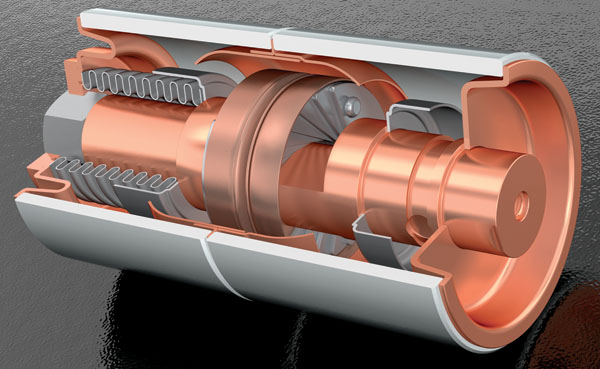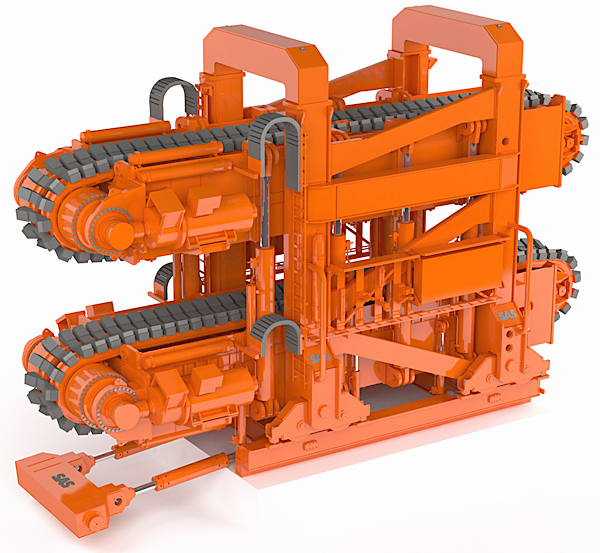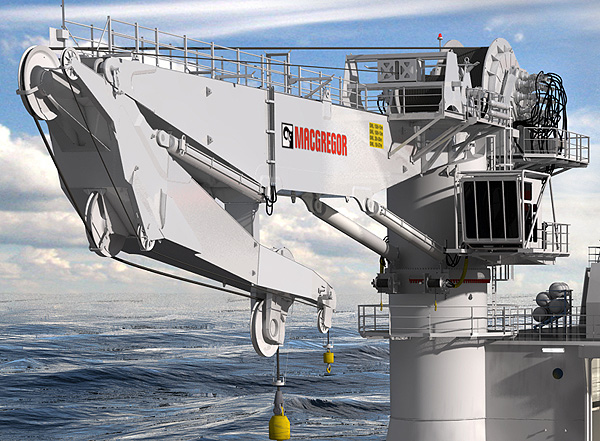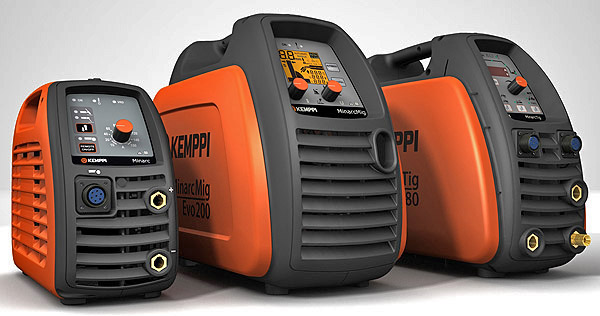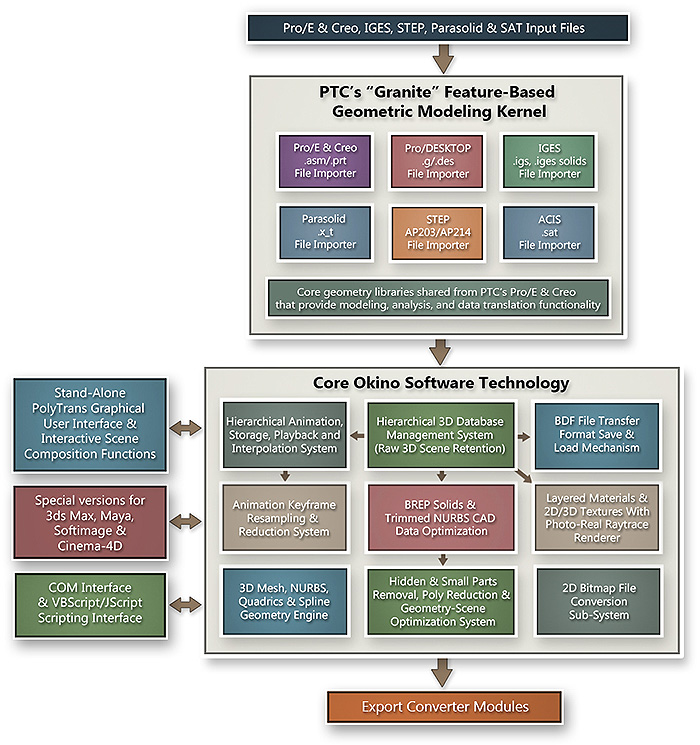| You are here: Home » Import CAD Formats » SAT (ACIS) |
|
See Also:
- Autodesk Inventor solutions page.
- IGES solutions page.
- Parasolid solutions page.
- ProE/Creo (Elements/Pro, Elements/Modeling, ProductView) solutions page.
- SolidWorks solutions page.
- STEP solutions page.
This suite of CAD importers, in the Granite/Pack module, is one of Okino's all time most popular solutions for our CAD customers - it is purchased along with almost every new Okino software license. In particular it is used for the handling of native and encrypted ProE/Creo files - there is technically no better solution to import such files. It also provides one of the world's most refined, fastest and reliable set of STEP and IGES CAD file importers, handling monstrous files that will just break any other CAD importer - they have been developed over a period of 3 decades and are used by a majority of Okino customers every hour.
Note: you would normally use the alternative Okino CAD/Pack-based converters for DWF-3D files (Inventor, AutoCAD, Navisworks, Revit), DXF/DWG files (AutoCAD and others), native Autodesk Inventor files, IFC files, PRC and 3D PDF files, native Solid Edge files and native SolidWorks files.
These CAD importers are used to move MCAD data from programs such as ProE/Creo, SolidWorks, Autodesk Inventor, Siemens UG NX, Solid Edge and CATIA (amongst many other MCAD modellers) into destination programs such as 3ds Max, Cinema-4D (C4D), Maya, LightWave, Unity and the Unreal Engine (via FBX, for VR/AR viewing), as well as all major 3D downstream 3D file formats such as Collada, DirectX, DGN, DXF/DWG, FBX, glTF, HOOPS/DWF-3D, JT Open, NGRAIN, OpenFlight, OSG/IVE, PLY, Rhino/OpenNURBS, SketchUp, U3D (Acrobat-3D, 3D PDF), USD, VRML1+2+X3D and Wavefront OBJ.
'Vacuum Interrupter' from 'One Space Designer' by Pieter Suur.
Converted via IGES BREP solids. See explanation here.
'Pipe Tensioner', via ProE/Creo, by Ludwig Desmet, Renderhouse BVBA. See explanation here.
Heavy Lifting Ship, via STEP/IGES/Parasolid, by Scott Garriott and Cargotec Corp. See explanation here.
Kemppi Welding Machines, via STEP, by Spikey Animation and Kemppi Oy. See explanation here.
For our common daily users, this module forms the MCAD back-bone to import from the most complex and massive STEP AP214 and AP203 files. Also, all variations of the 1980's "Bounded Surfaces", 1990's "Surfaced NURBS" and 2000's "BREP Manifold Solids" versions of IGES are robustly supported. While not recommended for CAD conversions, this module also supports the import of Parasolid .x_t and ACIS .sat files. It is highly recommended that you follow our short list of 'conversion rules' when sourcing your CAD files.
For ProE/Creo data users, this Okino CAD module inserts a real, live and embedded copy of the core ProE/Creo software inside of Okino software, allowing for the perfect import and translation of encrypted ProE/Creo files, up to the most recent version. No intermediate or reverse engineered file formats are used to convert the ProE/Creo data (as is most often used in other CAD programs).
It is licensed and sold as the optional low cost "Granite/Pack" add-on license. These formats play a pivotal role in bridging the CAD and industrial design markets with the non-CAD worlds of 3D DCC/Animation packages, authoring and VR/AR packages, VisSim packages, WEB publishing and polygonal modelers via the tried-and-tested Okino data translation pipelines offered in the PolyTrans & NuGraf packages.
Click on image to see full scale renditionThe importers also offer another means to transfer ProE/Creo data into Okino's NuGraf software which Okino has optimized for ProE/Creo users since the mid 1990's. When combined with Okino's CAD data optimization routines (for hierarchy & part count simplification), very complex assemblies can be imported, optimized, simplified, then re-exported to packages such as Unity & Unreal, 3ds Max (via native plug-ins in 3ds Max), CINEMA-4D, Maya (via native plug-ins in Maya/PC), LightWave, Blender DWF-3D, glTF, NGRAIN, OpenFlight/Creator, SketchUp, U3D (Acrobat-3D, 3D PDF) and USD, many others.
The following table of Granite/Pack supported file formats has been sorted by the general popularity of each file format to our typical customers:
Import Converter File Format Extension Version Import? ProE / Creo native .asm, .prt, .neu, .xpr, .xas Current PTC version Import STEP .stp, .step, .ste AP203 and AP214 Import IGES solids .igs or .iges All versions Import Parasolid .xmt, .xmt_txt, .xmt_bin, .xmt_neu, .x_t, .x_b, .x_n Various Import ACIS SAT .sat Various Import Granite "g-plugs" .g Various Import Creo Elements / View (PTC Product View) .pvs, .pvz, .edz, .ed, .ol Current PTC version Import Microstation DGN .dgn All versions Import ** It is highly recommended that you download the demo version of PolyTrans/NuGraf and test these importers on your dataset(s) before purchasing the Granite/Pack module.
NOTES:
- Adds a wealth of complementary 3D-solids-based file formats (ProE/Creo, IGES, STEP,
Parasolid and SAT), at a reasonable price, to the already extensive list of Okino supported CAD file formats.
- A highly developed and continually maintained set of importers by Okino. Okino has tested
these CAD converters with an absolutely vast number of CAD data files over 3 decades and continues to
do that daily with new customer data files. This is a highly refined and robust set
of CAD importers which we are very proud to support.
- Imports and retains: assembly hierarchy information, assembly names, BREP structure of the source model (bodies and faces), various material parameters, model units and units matching, meta data, and various attributes (hidden status).
- The quality of the model (the number of polygons) can be controlled via surface deviation, curve deviation and normal (angle) deviation controls.
- Import of independent NURBS curves, including composite and sketch curves. Not
all downstream file formats and programs will be able to handle such curves, but Okino's
internal 2D curves engine will allow them to be re-exported to many formats or programs
as NURBS curves, bicubic curves, polylines or line segments.
- Model processing functionality: (i) Apply data healing algorithms, (ii) Close open boundaries and, (iii) Simplify surfaces.
- Okino's "CAD Scene and Hierarchy Optimization System" has been integrated right into each of the
CAD importers. This optimizer is the crown jewel & "black magic" of Okino software which allows super-ultra-massive 3D MCAD models to
flow through to downstream 3D applications which would otherwise bottleneck on these large 3D datasets
(such as with Unity & Unreal for VR/AR, 3ds Max, CINEMA-4D, Maya, LightWave, Blender, etc).
- A number of professional and well implemented options that can be (optionally) set prior to import, to control most situations that could be encountered with CAD data import.
- Complete control over material parameter modification on an automatic basis. Many CAD systems have basic material parameters (like color, ambient + diffuse shading coefficients, opacity, etc) but when they are transferred over to a rendering and animation system they often look "too bright" or "highly ambient". This can be expected and is quite normal. The material tweak parameters easily allow such saturated shading values to be automatically compensated.
- Importing via a "solids-based" file format ensures that adjacent NURBS patches are "stitched" together via topology information (BREP data) and thus creates "crack free" tessellation when the NURBS or parametric solids are converted to a polygonal mesh.
- Given the recent hyperbolic increase in interest for CAD to VR (virtual reality) and AR (augmented reality), Okino's software is ideally
suited for severe CAD model reduction for efficient viewing in all current and near future head mounted
VR/AR devices using such software as Unity or the Unreal Engine. Okino has been directly and indirectly involved with VR since 1991
when Alias Research in Toronto first started to pursue this market.
- Intelligent support for importing PTC ProE/Creo part and assembly accelerator files (.xpr and .xas).
- If you perceive that not all of your parts are being import then please ensure that the "Import Quilts" option is enabled, and "Make Quilts Hidden" option is disabled on the Expert Geometry Processing wizard panel.
- Family table of instances in ProE/Creo files: if your part files use instances in family tables
then you must explicitly create instance accelerator files to go along with those instances in the
family tables (they are usually saved to disk by default by the PTC ProE/Creo software).
- STEP AP203 allows users to exchange geometry, topology and configuration data of a part or the whole product assembly. The user can exchange wireframe models, surface models and boundary representation of exact or faceted three-dimensional solids. STEP AP214 is a super set of AP-203 to define core data for automotive mechanical design processes.
- An 'assembly' file organizes one or more 'part' files into a more complex object. If your dataset consists of a main assembly file and multiple part files, then always just import the main assembly file (.asm).
- If there are multiple versions of a part file on disk (such as .prt.1, prt.2, .prt.3) then the newest part will always be opened (.prt.3).
PTC, ProE/Creo and Granite are trademarks or registered trademarks of Parametric Technology Corporation or its subsidiaries in the United States and in other countries. ACIS and SAT are registered trademarks of Spatial Corp. Parasolid is a registered trademark of Siemens Corp.


